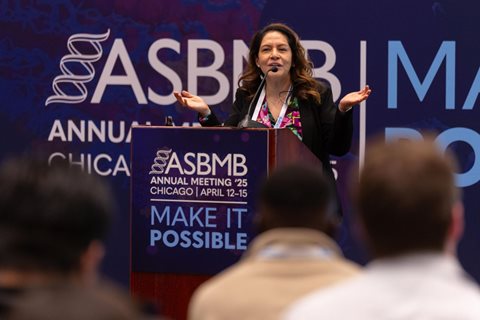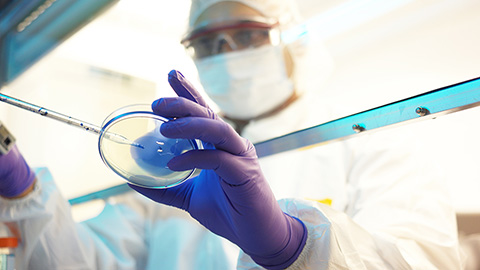How to plan a conference symposium
Discover BMB, the annual meeting of the American Society for Biochemistry and Molecular Biology, starts tomorrow! On the agenda are more than a dozen symposia, each of which includes a few talks centered on a theme — think cool and novel enzymes and signaling mechanisms in the nucleus.
Each session is led by one or two researchers and highlights new findings from experts in the field.

This week, I’m diving into what actually goes in to planning one of these symposia. Gina DeNicola, a professor at Moffitt Cancer Center, co-organized the redox and metals in biology session with Siavash Kurdistani, a professor at University of California, Los Angeles. DeNicola broke down the planning process for symposia, no matter the scale.
First things first: structure and guidelines
Scientific events vary in size and organizational structure. For larger meetings, the chief organizers might select the symposium themes first and then invite specific researchers to run the symposia. That’s how DeNicola got involved with Discover BMB.
But it’s also common for meeting organizers to put out an open call for proposals so that people can come up with the topics and run the symposia themselves. For example, the Discover BMB interest group sessions are derived from proposals. (Also, in a sort of hybrid approach, the ASBMB earlier this year invited members to nominate themselves for speaking opportunities relating to the 2025 symposia themes.)
If you are invited or volunteer to plan a symposium or any other type of session, it may seem daunting at first. DeNicola recommends looking at the timeline and breaking the work into specific tasks.
The first thing DeNicola and Kurdistani thought about was the structure of the symposium. They knew they had a certain number of speaking spots that were divided into subcategories. “Metals and redox biology is a big umbrella, so we (and the conference organizers) divided talks into three subcategories to make it more focused,” DeNicola said.
They then moved on to perhaps the most important step: selecting who would speak during the session. DeNicola said this was a collaborative effort. She and Kurdistani each came up with names for each subcategory and emailed them to each other. They followed this up with more discussions to figure out the details and make the final selections. The final selections were run by the conference organizers prior to sending out official invites.
“We both took initiative to identify speakers and also listened to each other’s recommendations,” she said. “We have different backgrounds: mine is in cancer and redox, and (Kurdistani’s) is in metal biochemistry. So we had different people in mind, which made the overall selections more well-rounded.”
DeNicola said they also considered guidelines provided by the conference organizers, so keep these in mind if you’re planning a session as well. For example, some conference organizers may seek to broaden participation and therefore discourage asking speakers who spoke the previous year or discourage inviting someone to talk at two different sessions during the same year.
Teamwork: coordination and cooperation
DeNicola and Kurdistani are at different institutions and on opposite sides of the nation — she’s in Florida and he’s in California — but they needed to plan the symposium together. DeNicola said they used email and Zoom meetings to stay in touch and on track. They mostly used email to decide on a plan, did the legwork separately, and then would meet over Zoom to discuss specific topics, such as selecting speakers.
“Email worked well to share documents and make quick decisions, and we would have longer discussions over Zoom,” she said.
DeNicola and Kurdistani also had to think about day-of practicalities. They each planned to chair one of the session’s subsections and then invited one of the speakers to chair the third. “The chairs are important to make sure the sessions are running smoothly and to direct questions,” DeNicola said.
She and Kurdistani also served as the point of contact for the invited speakers throughout the planning process. They answered questions about registration, travel and other conference logistics.
Value: ultimately worth doing
I asked DeNicola if she thought planning the session was a valuable experience and worth the work, and she said yes. “It’s rewarding to be able to direct and decide who’s going to be speaking and to interact with speakers I haven’t met previously,” she said. “I also hadn’t met (Kurdistani) before so getting to know him and his science better is a cool benefit.”
DeNicola also said the timeline is spread out enough that it’s not too much work at any one time, making it easier to manage on top of other responsibilities. However, she did recommend thinking about your other commitments before saying yes to planning a session.
“I agree to do a lot of things in advance and then when they happen, I realize it’s a lot of time,” she said. “I learned a lesson that when I agree to help with conference planning: I don’t agree to do more than one conference a year.”
You can learn more about the redox and metals in biology sessions (fun tidbit: the self-selected theme song for the symposium is Black Sabbath’s “Iron Man”) and learn about the other symposia details on ASBMB’s Discover BMB website.
Enjoy reading ASBMB Today?
Become a member to receive the print edition four times a year and the digital edition monthly.
Learn moreFeatured jobs
from the ASBMB career center
Get the latest from ASBMB Today
Enter your email address, and we’ll send you a weekly email with recent articles, interviews and more.
Latest in Careers
Careers highlights or most popular articles

Building the blueprint to block HIV
Wesley Sundquist will present his work on the HIV capsid and revolutionary drug, Lenacapavir, at the ASBMB Annual Meeting, March 7–10, in Maryland.

Upcoming opportunities
Present your research alongside other outstanding scientists. The #ASBMB26 late-breaking abstract deadline is Jan. 15.

Designing life’s building blocks with AI
Tanja Kortemme, a professor at the University of California, San Francisco, will discuss her research using computational biology to engineer proteins at the 2026 ASBMB Annual Meeting.

Upcoming opportunities
#ASBMB26 late-breaking abstract submission opens on December 8. Register by Jan. 15 to get the early rate on our Annual Meeting.

Make your abstract stand out
Ensure your research is impossible to overlook. Get quick, practical reminders for crafting an abstract that attracts readers and helps you build connections at the conference.

Inside industry postdocs
As more Ph.D. scientists look beyond academia, industry postdocs offer a new kind of training, where mentorship meets mission-driven research. Fellows at Pfizer and Genentech share how these programs prepare them to translate discovery into impact.

